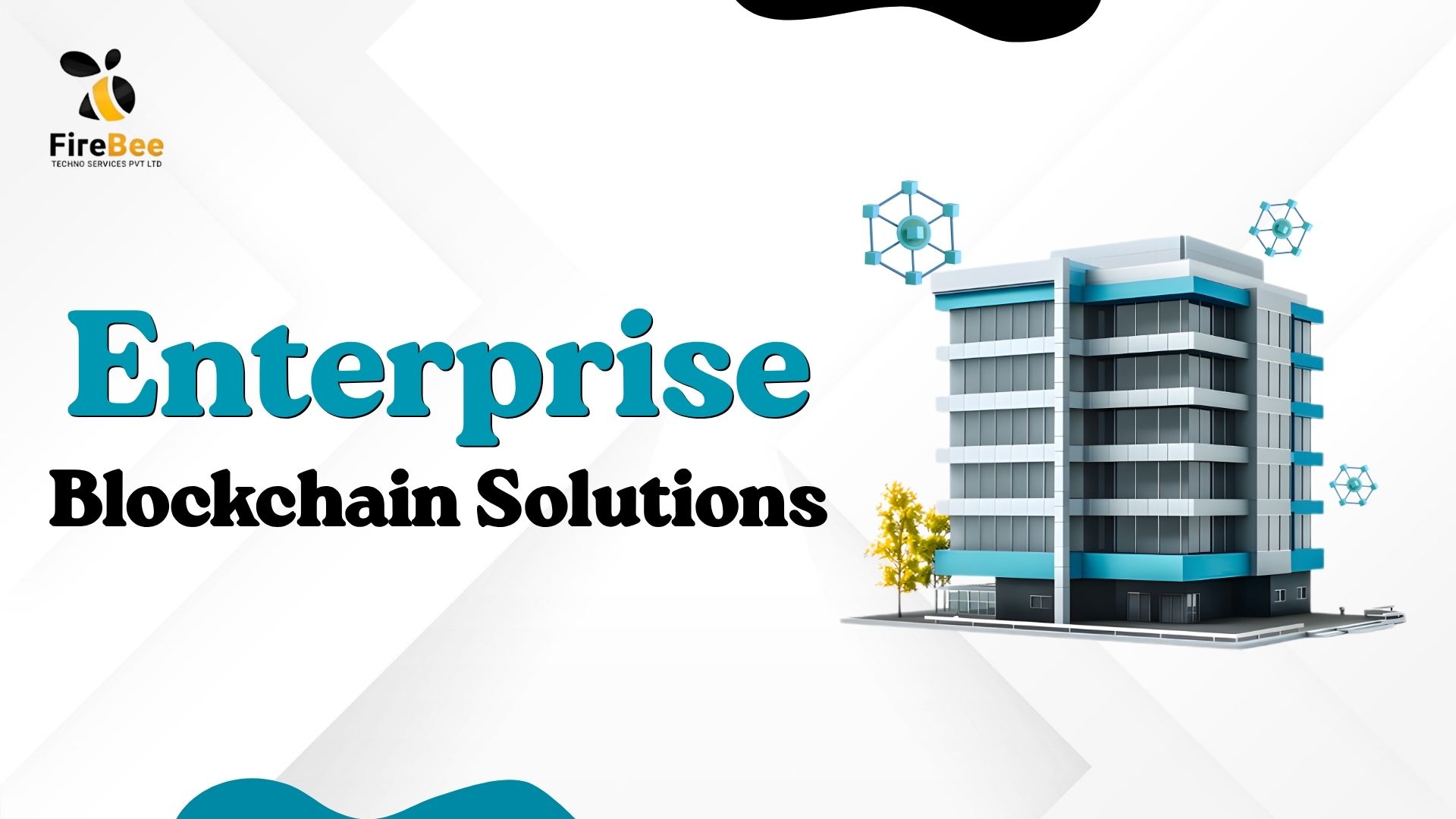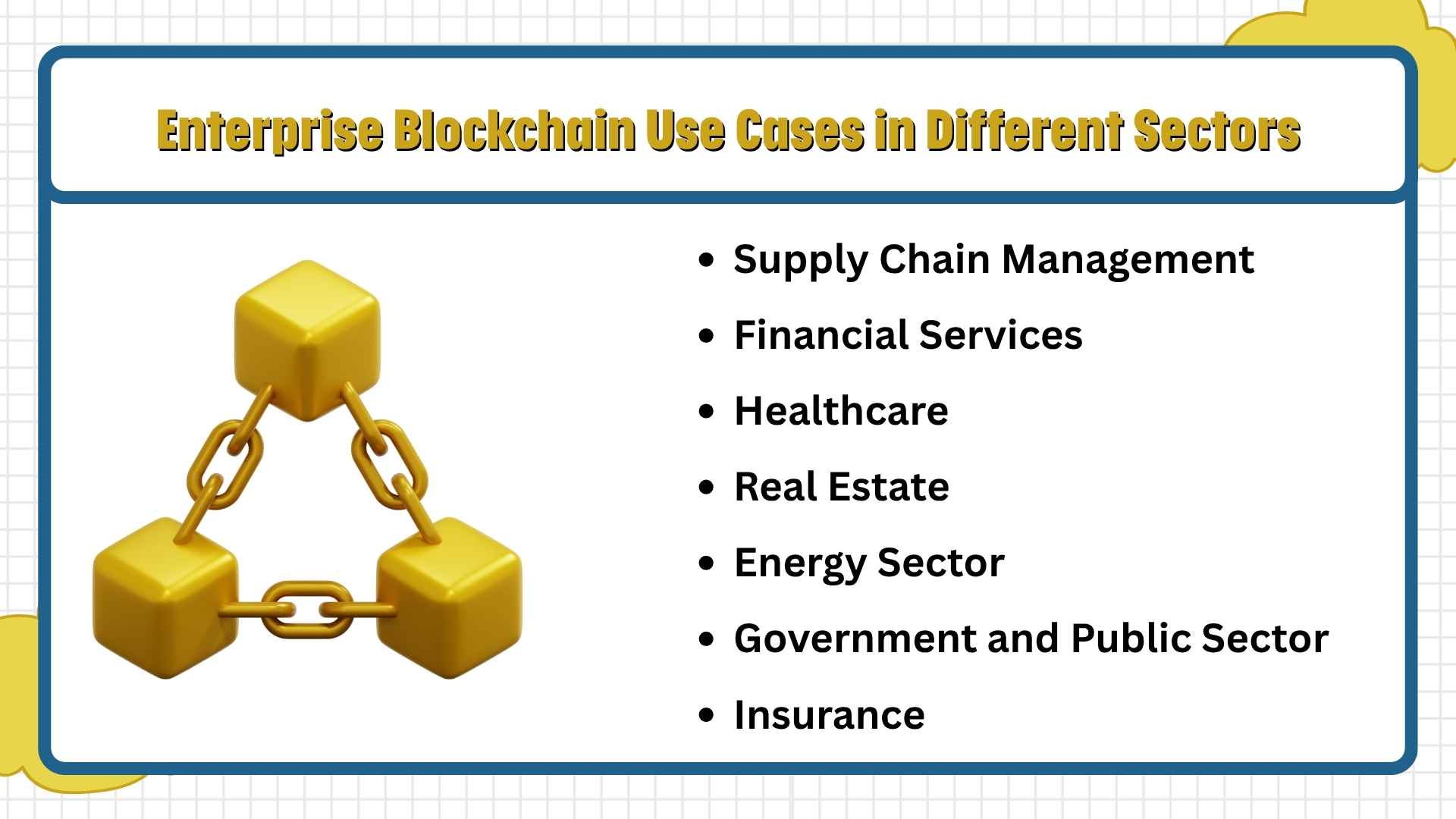
A Complete Guide to Enterprise Blockchain Solutions and Use Cases

Enterprise blockchain solutions started around 2015 with simple digital records and grew slowly with many companies. Market value reached over two hundred billion dollars by twenty twenty five, showing steady growth. Businesses report profit ratios between ten and thirty percent when using these solutions. Demand spans Europe, Asia and USA with thousands of firms adopting technology each year. This blog explores Enterprise Blockchain Solutions in detail.
What is Enterprise Blockchain?
Enterprise blockchain is a business-type blockchain made for company use, where networks stay private and permission-based for secure work and record storage between trusted groups. These networks share data carefully and safely. The global market keeps growing fast, as many reports note nearly 9.6 billion dollars in 2023 and can reach almost 146 billion dollars by 2030.
Key Components of Enterprise Blockchain Architecture
1. Blockchain Network Type
The structure of enterprise blockchain depends on the kind of network chosen, where public networks give open access, while private ones hold control with known users, and consortium types stay between both to share responsibility among trusted groups.
- Public Blockchains: The networks stay open for all users and work without permissions, where data stays visible and trust builds through open verification, though control and privacy stay low for business needs. The process takes power and time, which makes it less fitting for enterprise operations.
- Private Blockchains: The setup limits entry to selected users and keeps control within a closed group where companies run it for safety and order, and do not depend on full decentralization. The method works best when data and actions need protection within fixed roles.
- Consortium Blockchains: The structure stands between open and private types, where many organizations join to manage the network and share authority. The pattern brings balance between control and fairness while keeping security and agreement at high levels.
2. Consensus Mechanisms
The network runs through a shared agreement where several rules make all members accept one record and avoid conflict. The methods define how blocks get approved and how fast actions are completed in secure ways.
- Proof of Work: The method uses high computing effort to check transactions where energy use stays heavy, though trust grows strong by design. It fits open chains but faces a slower speed for enterprise tasks.
- Proof of Stake: The method allows holders to lock assets to verify actions, which saves power and quickens block time. The model keeps a balance between energy saving and secure agreement for private use.
- Byzantine Fault Tolerance: The rule helps closed and shared blockchains to reach a clear agreement with very low delay. The setup gives strong security and quick completion, making it useful for enterprise platforms.
3. Smart Contracts
The small digital rules run business actions by themselves and remove the need for middle approval. The logic stays written inside the code and works on every node to keep trust and steady results.
4. Identity Management
The control management defines who can join and what they can do in the network, and keeps all actions traceable. The design protects information and supports compliance within enterprise boundaries.
5. Data Storage
The location of data changes how the network grows, where on-chain keeps records fixed while off-chain keeps data flexible. A mix of both gives balance for space, speed, and safety.
6. APIs and Integration
The API connects blockchain with existing tools through defined links and lets information pass between databases and apps. The method keeps business functions steady without breaking old structures.
7. Governance
The setup defines how decisions move inside the network, where updates, disputes, and control rules are clear. The structure helps in long-term operation and keeps the group’s purpose aligned.
8. Architectural Design Patterns:
- Federated Architecture: The design spreads nodes between organizations and gives each one shared control. The form strengthens stability and fairness across the network.
- Tiered Architecture: The pattern separates data checking and application layers to make performance smooth. The method supports safety and scaling for big enterprise use.
- Sidechains or Off-Chain Channels: The side networks work beside the main one and move some load away to gain faster action. The approach also allows selective privacy when needed.
- Hybrid Architectures: The setup mixes both open and closed networks to gain benefits from each while reducing weak points. The structure helps partial data sharing in safe ways.
- Microservices Architecture: The form cuts blockchain work into small, independent parts that run alone but stay connected. The design makes updates and scaling easier across networks.
Major Benefits of Enterprise Blockchain Adoption
- Transparency: The record of each transaction stays open in a shared book that anyone can check at any time. The clear record makes cheating harder and builds trust among many business partners.
- Enhanced Security: The data stays safe inside a digital network where each record connects strongly to the one before it. The information spreads across many networks, which makes it very hard for attackers to change anything.
- Improved Efficiency: The automatic programs called smart contracts do the work that used to need middle agents. The speed of doing business actions becomes higher, and decisions happen much faster.
- Cost Reduction: The use of blockchain removes the need for several middle layers in business tasks. The saving of money also appears in the checking of data and the process of reviewing accounts.
- Better Traceability: The clear line of records shows where every product or asset came from and where it goes. This feature helps businesses keep goods true and in line with business rules.
- Increased Collaboration: The technology lets many groups share data safely without losing privacy. The connection between businesses becomes stronger and more open for long-term projects.
Top Enterprise Blockchain Platforms
| Hyperledger Blockchain | A closed and controlled blockchain network under the Linux Foundation with a structure that allows many changes. Its type stays permissioned, and the method of agreement can change as per setup. The framework fits supply chain healthcare and finance because it has a flexible structure and solid support from developers. |
| R3 Corda Blockchain | A private blockchain designed mainly for use in financial areas where privacy remains important. The network allows only the needed parties to view the data while supporting contract automation in banks. Its Type stays permissioned with an agreement done through special notary services. |
| Ethereum Enterprise Blockchain | A private model built from the public Ethereum network offering contract features and wide community tools. Many businesses use it in areas like finance and logistics for smooth operations. Its type can stay open or permissioned using a proof-based agreement. It works well for token-based and application-based setups. |
| Quorum Blockchain | A corporate form of Ethereum made by JPMorgan that brings better privacy and quick performance. This network fits well for financial projects that deal with sensitive records. Its type stays permissioned with the Raft method used for consensus building. It also works for supply chains and enterprises with strong privacy. |
Real-World Enterprise Blockchain Use Cases

1. Supply Chain Management
Transparency gives every party one shared record that helps reduce disputes during trade and transport. Traceability allows businesses to follow where a product traveled to reach its final place to ensure quality.
2. Financial Services
Border Payments uses blockchain for quick and low-cost transfers that move across countries without delay. Smart Contracts help with automatic deal execution, which removes middle agents and shortens the time in financial processes.
3. Healthcare
Patient Records stay safe inside blockchain, where hospitals and clinics can access needed data without fear of misuse or loss. Drug Traceability lets companies check where each medicine came from and confirm that no fake drugs enter the system.
4. Real Estate
Property Transactions move faster when blockchain keeps all ownership details visible and correct in one ledger. Smart Contracts make property transfers simple and remove long paper steps through coded agreements.
5. Energy Sector
Peer-to-Peer Energy Trading gives people the chance to sell directly to others. Grid Management improves when energy data moves instantly across blockchain networks, helping to better supply and load balance.
6. Government and Public Sector
Voting platforms gain trust when blockchain records votes securely and prevents tampering of election results. Identity Verification creates safe digital identities that stop fraud and help citizens access online services quickly.
7. Insurance
Claims Processing becomes smooth when smart contracts approve valid claims automatically, reducing cost and time. Fraud Detection becomes easier since blockchain’s open records expose false or repeated claim attempts.
Why Choose Fire Bee For Enterprise Blockchain Solutions?
- Highly skilled team: We have wide experience in creating blockchain solutions for many business sectors. Our experts bring deep skill that helps in shaping secure and steady digital setups.
- Reliable Development Process: Our experts follow a clean process that keeps every part tested and checked for balance. The final result works with strength and gives a long service timeline for the business.
- Strong Technical Support: We keep the support team active after the project launch to check updates and issues. The continuous care helps the blockchain network stay healthy and steady.
- Custom Blockchain Integration: Our experts design blockchain models that suit the business workflow with smooth data flow. Our blockchain solutions stay linked with older tools without breaking the present structure.
- Future Ready Blockchain Solutions: We make platforms that grow with rising business demand without big changes. Our blockchain solutions keep space for future add-ons and wider network reach.
Conclusion
Enterprise blockchain solutions hold a strong promise for stable growth and long-term development in many industries. Businesses see clear paths to secure data and reliable processes that continue over time.
Fire Bee Techno Services offers Enterprise Blockchain Development Solutions to transform your business and provide long-term growth. Contact our experts to start implementing secure and reliable enterprise blockchain strategies today.






